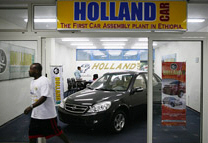
Typical street scene in Santa Ana, El Salvador. (Photo: iStock)
IMF Survey: Can Africa Make Trade an Engine for Growth?
March 11, 2008
- Sub-Saharan Africa's share in global trade has declined since 1970
- But its trade prospects have improved with the recent commodity boom
- Region needs focus on macroeconomic stability, infrastructure, and business climate
The long-term decline in sub-Saharan Africa's share in global trade can be attributed to such factors as macroeconomic instability, high and cascading tariff structures, and unfavorable cost structures as a result of poor business environments, small domestic markets, and high indirect costs.

Ethiopia has unveiled its first locally-assembled saloon car—with parts imported from China. The car named Abay—Amharic for the Blue Nile—was launched in October 2007. (photo: Jose Cendon/AFP)
Asia-Africa Trade
But, well endowed with natural resources, the region is benefiting from the recent commodity boom, which has reoriented its trade toward Asia's rapidly growing emerging economies—for example, China and India.
Most of sub-Saharan Africa's domestic markets are small, so that exports to Asia offer the region's producers opportunities to vastly expand their markets. Such an upturn could help lay the foundation for sustained growth in sub-Saharan Africa.
A new IMF study, Sub-Saharan Africa: Forging New Trade Links with Asia, by Kevin Carey, Sanjeev Gupta, and Ulrich Jacoby, analyzes the trade patterns emerging in sub-Saharan Africa and assesses their implications for policy. It also analyzes merchandise trade in terms of product groups that are gaining acceptance in industrial and fast-growing emerging economies and explores whether, overall, the region is under- or overtrading.
Policies to enhance trade potential
The study finds evidence that sub-Saharan Africa is performing below its export potential. Its export growth derives from both fuels and manufactures, but manufactures are limited to a few products and are concentrated in southern Africa.
The study concludes by suggesting policies that would help sub-Saharan Africa realize its full trade potential. These include
• maintaining macroeconomic stability, building infrastructure, and reducing the cost of doing business, which would promote growth and trade. Such measures would also help the region gain a share of the growing outsourcing of services by industrial countries.
• liberalizing trade through a gradual but substantial reduction in most-favored-nation tariffs. This would improve resource allocation while limiting incentives to circumvent customs.
• reducing shipping costs, such as port charges, customs clearing, and internal freight.
In addition, the study discusses policies that would help sub-Saharan Africa's coastal, landlocked, and resource-intensive countries improve their trade prospects.


